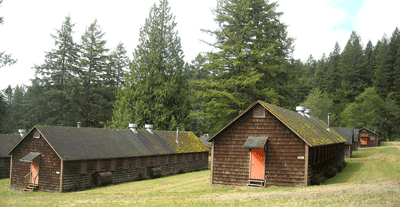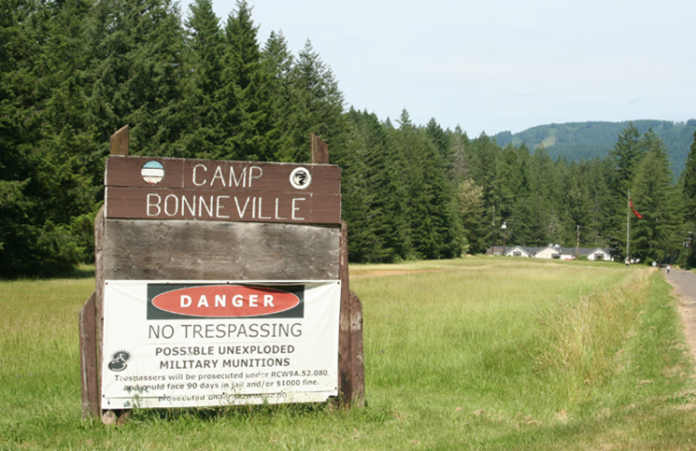Clark County businesses have a unique opportunity to help define a major local attraction. The County Board of Councilors will soon launch a new advisory committee to help shape the future of Camp Bonneville, including choosing a new name.
“We can see it (Camp Bonneville) as opportunity and have it pay for itself, or have it be a huge detriment to our budget,” said Councilor Chair Marc Boldt. “We have the next three years to figure this out.”
Boldt wants local businesses to get involved with the advisory committee, to inform the county about what will attract people and what it will take to make the park financially viable.
“It’s more of a business venture than a park venture,” said Boldt.
“A public/private partnership makes sense, because the county has always seen it as a self-sustaining venture,” explained Jerry Barnett, who, as part of his job with the county’s Public Works department, is cleanup manager for the camp.
 So, what does Clark County have to work with? Camp Bonneville consists of 3,840 acres of natural open space and two major camps of old buildings; much of the property is steep, and more than half of its six square miles is forested. Named after Army Capt. Benjamin Bonneville, an early explorer credited with charting much of the Oregon Trail, the site borders both sides of Lacamas Creek and lies about seven miles north of the Columbia River. There are only two entrances, with either chain-link or 5-strand barbed wire controlling access on the perimeter.
So, what does Clark County have to work with? Camp Bonneville consists of 3,840 acres of natural open space and two major camps of old buildings; much of the property is steep, and more than half of its six square miles is forested. Named after Army Capt. Benjamin Bonneville, an early explorer credited with charting much of the Oregon Trail, the site borders both sides of Lacamas Creek and lies about seven miles north of the Columbia River. There are only two entrances, with either chain-link or 5-strand barbed wire controlling access on the perimeter.
“I consider it an attraction now – it’s a beautiful place,” Barnett stated. “But we need to let people know it used to be an Army facility, so controlled access is necessary.”
The camp was established in 1909 as a drill field and rifle range for the Vancouver Barracks and was used primarily as a training camp for various branches of the military for 85 years. The camp was also reputedly used as an Italian POW camp during WWII. Camp Bonneville was officially closed in 1995 by the Base Realignment and Closure Commission. The Army reached out to local agencies and eventually chose Clark County as the “local reuse authority” for the property, with the stipulation that the county would conserve the natural aspects of the camp. In a three-way partnership, the Army is footing the bill for the site’s cleanup, while the Department of Ecology and the county coordinate to oversee the cleanup.
In October 2006, the Army transferred the Camp Bonneville deed to Clark County. An Amended Prospective Purchaser Consent Decree with Clark County was entered into Clark County Superior Court in May 2012 (The decree outlines the investigation and cleanup actions, and provides the legal framework and assurances that the project will be completed as planned for the entire site). The Army retains liability for any munitions or contamination that isn’t found during the cleanup.
Within the site there are about 25 firing ranges for various weapons and several non-firing training areas. Boldt explained that “when we first started this [in the mid-90s], we took the Army’s word that it wasn’t that bad off.” He said the Army thought a $15 million budget and three years would be sufficient for cleanup.
“But it’s really been a long time and $40 million has been spent so far,” stated Boldt.
Rifle and pistol rounds, artillery shells, bazooka rounds, mortar shells and grenades all have been uncovered at Camp Bonneville, along with an assortment of practice munitions, illumination flares and smoke grenades. Less than 1 percent of the items uncovered are actual live rounds. Early in the cleanup, the Army told the county it should expect to find around 15 to 20 dangerous devices in the ground. Instead, by 2012 more than 1,500 had been found. Barnett said the most unusual thing they’ve found so far is a 155mm shell. Since the firing gun for that large of a shell is between 20 and 30 miles, “that’s a very large shell to be out here,” said Barnett.
Barnett agreed that “there was significantly more contamination than everyone thought,” but is excited that the cleanup should finally be finished in about three years. Barnett said that phase one (clearing Camp Bonneville’s 445-acre central valley floor from all metals including munitions to a depth of 14 inches) and phase two (clearing the demolition area and firing ranges) have now been completed. Weston Solutions Inc., a Pennsylvania-based environmental remediation and engineering firm, is the county’s contractor for Camp Bonneville’s cleanup.
The next phase, phase three, is to clear the 500-acre central impact target area, where artillery gunners practiced firing 105mm howitzers and other guns at car bodies, refrigerators and other large items. This heavily contaminated portion of the camp will never be open for public use, even when the cleanup is complete. Finally, phase 4 is clearing the “western slopes” (the area to the west of the central valley floor).
Now that there is light at the end of the tunnel for the cleanup effort, the county is anxious to start hearing ideas about how the area might generate revenue and serve to attract tourists and residents alike. There was a formal reuse plan with revenue projections filed in 2003, but many of the partners who expressed interest at that time have since moved on because the cleanup effort has dragged out.
There is an existing law enforcement firing range on the property, which gets regular use from local police officers, but Barnett said it will be relocated at some point. The county has removed a little over 1,100 cunits (a unit of volume used for pulpwood, equal to 100 cubic feet of solid wood) of Douglas Fir from the site, using the resulting timber revenues to replace five bridge decks and four roofs. The county received dual certification from the Forest Stewardship Council and the American Tree Farm System’s Sustainable Forest Initiative, recognizing Clark County’s commitment to sound land management. The Forest Stewardship Plan can be found at www.clark.wa.gov/environment/index.asp.
The advisory committee will help the county find the “highest and best use” for the site. Yurts and camping, a tram, an equestrian center, firing and archery ranges, an outdoor school, and a “rustic retreat” are all on the 2003 reuse plan. Looking around the Pacific Northwest, it seems that other possibilities are myriad for retaining the natural aspects of the area while attracting visitors. Equestrians, bicyclists, 4-wheeler and motorcross enthusiasts want trails. Paintball and airsoft is popular. “Glamping” (glamorous camping) is a growing trend, as are zip lines and rock-climbing walls. Senior play parks, “splash play” areas, community gardens, an outdoor museum, a dog park or even augmented reality experiences could also be explored.
Councilor Boldt is hoping that area businesses will join him in his enthusiasm for making Camp Bonneville a star attraction in Clark County, and invites any business owners who are interested in serving on the advisory committee to contact him.
Boldt can be reached at marc.boldt@clark.wa.gov.
Learn more about Camp Bonneville by visiting www.clark.wa.gov/public-works/camp-bonneville.




